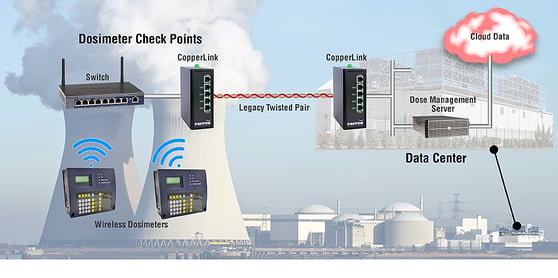When the Limerick Generating station needed to upgrade a dosimeter management system in the Nuclear Reactor Building, they needed a way re-use legacy cabling embedded in concrete barriers.
 Exelon's Limerick Generating Station is the 600-acre home to two nuclear reactors that produce 2,317 megawatts of zero-emissions energy. The plant is connected to the grid by several 500kv transmission lines. That's carbon-free electricity to power 2 million homes.
Exelon's Limerick Generating Station is the 600-acre home to two nuclear reactors that produce 2,317 megawatts of zero-emissions energy. The plant is connected to the grid by several 500kv transmission lines. That's carbon-free electricity to power 2 million homes.
Safety is of course this facilities first and highest obligation. Nuclear power plants are among the best-protected private sector facilities in America, with monitoring and inspections by plant owners, local officials and the federal government.
The nuclear reactors are surrounded by multiple physical barriers. The first barrier is the fuel itself which is sealed in fuel rods made of a metal alloy that resists heat, radiation and corrosion, which are assembled into the nuclear reactor core. That core is inside a reactor vessel, which has steel walls that are about six inches thick. The reactor vessel sits inside a containment structure, which itself if enclosed in steel-reinforced concrete about five feet thick.
For the dedicated people who maintain the generation plant, exposure to potentially dangerous radiation levels needs to be carefully controlled. That is why Limerick operates a dosimetry system, which monitors the cumulative radiation dose for each worker. In the nuclear power industry, dose-management is not optional.
But like any other field, technology changes, including the dosimetry equipment used by Exelon. It was going obsolete and newer better products were available. Exelon did not waste time finding a replacement dose-management system.
The old system was based on Serial Communications and the dosimetry data was transmitted over copper twisted pair wires. The copper wiring was installed when the plant was built and is integrated in the concrete and steel infrastructure, which forms safety barriers. The data is aggregated from various locations in the reactor-building complex to the data center several thousand feet away.
The new system is all based on Ethernet and Ethernet requires either Fiber or more current grades of cable (CAT-4). Also, the 328-foot distance limitation for Ethernet would not support the cable runs at the plant. Pulling fiber cables to critical checkpoints inside the reactor, dry well, and fuel floor areas would require penetrating, resealing, and re-testing multiple concrete fire walls.
The estimated cost was about $1 million and prohibitive. That's when Exelon called Patton. They talked about the new Electronic Personal Dosimeters (EPDs) and explained the networking problem and put us in contact with engineers from Siemens.
Much to the relief of Exelon, the problem could be solved. Using 16 pairs of Patton's CopperLink Ethernet Extenders, Patton was able to deliver high speed Ethernet connectivity for runs up to 4,500 feet over single twisted pairs leveraging the plant's legacy copper infrastructure.
And Patton deployed the solution really fast. In this technology transition, the minutes really count. When the plant goes down for maintenance, every minute means lost revenues. At its bustling peak, 850 workers must check dosimeters in and out each day, so efficiency pivots on key dosimetry checkpoints located inside the reactor building complex.
Patton's variable rate features also allowed Exelon to adjust line rates to achieve peak reliability on links with different distances and different noise levels while meeting or exceeding high speed (close to real time) data transmission requirements.
.png?width=259&height=111&name=LOGO%20technologies%20v2%20(5).png)

